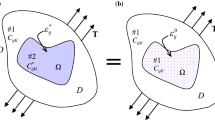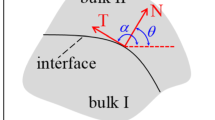Abstract
In order to take into account the effect of a finite interfacial zone between the inhomogeneity and matrix in an inhomogeneous representative volume element (RVE), analytical solutions for a 3-phase inclusion problem are needed. In this study, the primary focus is placed on a 3-phase concentric configuration for a 2D RVE, for which the exterior matrix is bounded and different elastic properties are assigned to the interior inclusion, interfacial zone and exterior matrix. In addition to the inhomogeneity induced by material mismatch, arbitrary uniform eigenstrains are allowed to occur independently within the interfacial zone and inclusion, respectively. In this study, the analytical solution is pursued via the complex potential method with the aid of 2 auxiliary potential functions. Based on the Sokhotski–Plemelj theorem, the complex potentials in each phase are constructed to account for the eigenstrains existing in the inclusion and the interfacial zone, as well as the imposed boundary conditions on the exterior matrix. The identification of the coefficients in the complex potential functions gives the analytical expressions for the disturbance induced by the inhomogeneity and eigenstrains. When compared with FEM simulations, a firm agreement is achieved for 3-phase concentric 2D finite domains. Furthermore, if the exterior matrix is extended to infinity, the obtained analytical solution reproduces the results given by Luo and Weng for uniform eigenstrain within the inclusion and by Markenscoff and Dundurs for uniform eigenstrain in the interfacial zone.
Similar content being viewed by others
References
Eshelby J.D.: The determination of the elastic field of an ellipsoidal inclusion, and related problems. Proc. R. Soc. Lond. A 241, 376–396 (1957)
Eshelby J.D.: The elastic field outside an ellipsoidal inclusion. Proc. R. Soc. Lond. A 241, 376–396 (1959)
Nemat-Nasser S., Hori M.: Micromechanics: Overall Properties of Heterogeneous Materials, vol. 2. Elsevier, Amsterdam (1999)
Rodin G.J.: Eshelby’s inclusion problem for polygons and polyhedral. J. Mech. Phys. Solids 44, 1977–1995 (1996)
Mori T., Tanaka K.: Average stress in matrix and average elastic energy of materials with misfitting inclusions. Acta Metall. 21, 571–574 (1973)
Hill R.: A self-consistent mechanics of composite materials. J. Mech. Phys. Solids 13, 213–222 (1965)
Nozaki H., Taya M.: Elastic fields in a polygon-shaped inclusion with uniform eigenstrains. J. Appl. Mech. 64, 495–502 (1997)
Nozaki H., Taya M.: Elastic fields in a polyhedral inclusion with uniform eigenstrains and related problems. J. Appl. Mech. 68, 441–452 (2001)
Kuvshinov B.N.: Elastic and piezoelectric fields due to polyhedral inclusions. Int. J. Solids Struct. 45, 1352–1384 (2008)
Li Q., Anderson P.M.: Dislocation-based modeling of the mechanical behavior of epitaxial metallic multilayer thin films. Acta Mater. 53, 1121–1134 (2005)
Scrivener, K.L.: The microstructure of concrete. In: Skalny, J.P. (ed.) Material Science of Concrete, vol. 1, pp. 127–162. American Ceramic Society, Westerville (1989)
Sun, Z.H., Garboczi, E.J., Shah, S.P.: Modeling the elastic properties of concrete composites: experiment, differential effective medium theory, and numerical simulation. Cem. Concr. Compos. 29, 22–38 (2006)
Ryu I., Choi J.W., Cui Y., Nix W.D.: Size-dependent fracture of Si nanowire battery anodes. J. Mech. Phys. Solids 59, 1717–1730 (2011)
Kim H., Cho J.: Superior lithium electroactive mesoporous Si@ Carbon core- shell nanowires for lithium battery anode material. Nano Lett. 8, 3688–3691 (2008)
Luo H.A., Weng G.J.: On Eshelby’s inclusion problem in a three-phase spherically concentric solid, and a modification of Mori-Tanaka’s method. Mech. Mater. 6, 347–361 (1987)
Luo H.A., Weng G.J.: On Eshelby’s S-tensor in a three-phase cylindrically concentric solid, and the elastic moduli of fiber-reinforced composites. Mech. Mater. 8, 77–88 (1989)
Christensen R.M.: Mechanics of Composite Materials. Wiley, New York (1979)
Li G., Zhao Y., Pang S.-S.: Four-phase sphere modeling of effective bulk modulus of concrete. Cem. Concr. Res. 29, 839–845 (1999)
Duan H.L., Jiao Y., Yi X., Huang Z.P., Wang J.: Solutions of inhomogeneity problems with graded shells and application to core–shell nanoparticles and composites. J. Mech. Phys. Solids 54, 1401–1425 (2006)
Markenscoff X., Dundurs J.: Annular inhomogeneities with eigenstrain and interphase modeling. J. Mech. Phys. Solids 64, 468–482 (2014)
Ru C.Q.: A new method for an inhomogeneity with stepwise graded interphase under thermomechanical loadings. J. Elast. 56, 107–127 (1999)
Ru C.Q.: Three-phase elliptical inclusions with internal uniform hydrostatic stresses. J. Mech. Phys. Solids 47, 259–273 (1999)
Wang X., Gao X.-L.: On the uniform stress state inside an inclusion of arbitrary shape in a three-phase composite. Z. Angew. Math. Phys. 62, 1101–1116 (2011)
Wang, X.: Eshelby’s inclusion and dislocation problems for an isotropic circular domain bonded to an anisotropic medium. Acta Mech., (in press) (2014)
Li S., Sauer R.A., Wang G.: A circular inclusion in a finite domain I. The Dirichlet-Eshelby problem. Acta Mech. 179, 67–90 (2005)
Wang G., Li S., Sauer R.: A circular inclusion in a finite domain II. The Neumann–Eshelby problem. Acta Mech. 179, 91–110 (2005)
Li S., Sauer R.A., Wang G.: The Eshelby tensors in a finite spherical domain—part I: theoretical formulations. J. Appl. Mech. 74, 770–781 (2007)
Li S., Wang G., Sauer R.A.: The Eshelby tensors in a finite spherical domain—part II: applications to homogenization. J. Appl. Mech. 74, 784–797 (2007)
Timoshenko S.P., Goodier J.N.: Theory of Elasticity. McGraw-Hill, New York (1970)
Muskhelishvili N.I.: Some Basic Problems of the Mathematical Theory of Elasticity. Noordhoff, Groningen (1953)
Sherman, D.I.: On the problem of plane strain in non-homogeneous media. Non-homogeneity in Elasticity and Plasticity, pp. 3–20 (1959)
Xu, X.F., Chen, X.: Stochastic homogenization of random elastic multi-phase composites and size quantification of representative volume element. Mech. Mater. 41, 174–186 (2009)
Pan, C., Yu, Q.: Inclusion problem of a two-dimensional finite domain: the shape effect of matrix. Mech. Mater. 77, 86–97 (2014)
Author information
Authors and Affiliations
Corresponding author
Rights and permissions
About this article
Cite this article
Pan, C., Yu, Q. Disturbed elastic fields in a circular 2D finite domain containing a circular inhomogeneity and a finite interfacial zone. Acta Mech 226, 1457–1470 (2015). https://doi.org/10.1007/s00707-014-1263-5
Received:
Revised:
Published:
Issue Date:
DOI: https://doi.org/10.1007/s00707-014-1263-5




